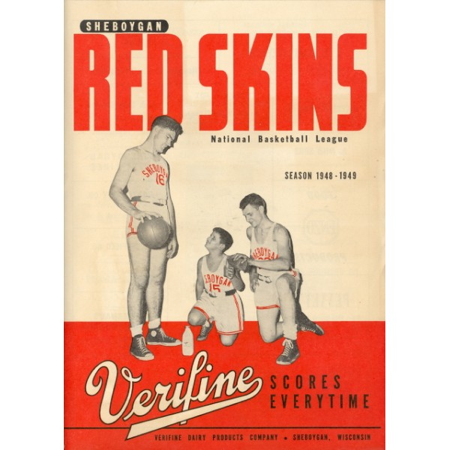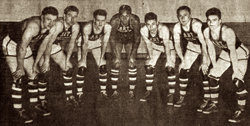Brian Gaynor of the Des Moines Register copped some nice research about the breaking of the racial color barrier in the old National Basketball League, for a piece he wrote that appeared this week in the Sheboygan Press.That milestone happened in 1942 with the Chicago Studebakers and the Toledo Jim White Chevrolets, the two teams which had signed numerous African American players that year — the first time a major professional sports league had done so (see Black Fives Blog: Was Baseball Racial Integration Leader? Or Basketball?, and Black Fives Blog: Toledo (Ohio) Black Basketball History).Both teams visited Wisconsin to play the Sheboygan Redskins, a team that eventually joined the National Basketball Association. The Studebakers got there first.Gaynor:
Few of the 3,000 locals in attendance on Nov. 25, 1942, knew the magnitude of the moment when Bernie Price, Hillary Brown, Duke Cumberland, Sonny Boswell, Tony Peyton and Roosie Hudson emerged from their locker room with four white teammates to play the Red Skins. What those fans cared about most was that Sheboygan opened the National Basketball League season on a positive note, 53-45, over the Chicago Studebakers.
More:
“There had been token integrations before (in lesser leagues), but this was THE integration that marks the start for pro basketball and for major professional-league sports,” said [Bill] Himmelman, who served as the NBA’s historian from 1985 to 2002. “About 30 years ago, I had the pleasure of spending time with the Studebaker players. They said they felt shortchanged as the ones who truly integrated pro sports, rather than Jackie Robinson and all the rest. The NBL was the trendsetter there.”
By the time the Studebakers arrived in Sheboygan, fan interest in basketball there already trumped most concerns about race (see Black Fives Blog: Early Racial Inclusion Puts Wisconsin On Pro Basketball Map).
Gaynor expands on this:
“They were always treated good because they made good money, working at the plant and playing for Studebaker,” said Al Price, whose late brother Bernie was Chicago’s second-leading scorer.
As luck would have it, the Studebakers’ opener just happened to be played in Sheboygan. Some nights later, Toledo suited up four black players — Bill Jones, Shanty Barnett, Al Price and Casey Jones — for their season opener. These dual events came eight years before Earl Lloyd became the first black player to step onto an NBA court.
“Some of the towns we played in weren’t too cool,” said Price, 92, who still lives in Toledo. “That was just the way people were and how they felt. All across the country, discrimination was going on. Some cities and towns were very prejudiced and others were very receptive. Just like people are today, good and bad. I don’t remember how Sheboygan was.”
The last player remaining from that trailblazing Chicago-Sheboygan game is Red Skins forward Ken Buehler, who scored 14 points against the Studebakers and would be named the NBL’s rookie of the year that season.
“When I played at Milwaukee State Teachers College, we had a black player on the team, so it was nothing new,” said Buehler, 89, who lives in South Palm Beach, Fla. “As for the Studebakers having black players, nobody thought anything of it, as far as race relations go.”
 And still further, in a related item by Gaynor:
And still further, in a related item by Gaynor:
And perhaps most noteworthy, the Harlem Globetrotters, also in the Naismith Hall of Fame, held their first training camp in November 1940 in, of all places, Sheboygan. Red Skins coach Frank Zummach said team publicity director Michael Progar, who worked at the Press, had a plan.
“He was the guy who organized it and got them to come,” said Zummach, still sharp at age 98. “The Globetrotters had never done that before. I always give him credit because he pulled it off.”
The Globetrotters planted roots in Sheboygan and stayed at the Park Hotel, across from Fountain Park on the site where the old Sheboygan Clinic would be built.
“We had a good 10 days of practice,” Zummach said. “At the end, we played two exhibitions, one I believe was in Plymouth and the other at the Eagles hall in downtown Sheboygan. By that time, the Globetrotters were pretty well-known and they were not yet clowning.”
And the Red Skins, now fit and ready after training hard against the Trotters, got new wheels for their season-opening trip out East.
“We made a deal and we took the Globetrotters’ old bus and they got a new one,” Zummach said. “We drove the Trotters’ bus out to Akron and then to Detroit and stayed overnight outside Detroit, where the bus died. We just left it there and took a train back to Sheboygan.”
It would be nice to have seen that old bus. Maybe it was a vintage Reo Speedwagon, the kind theNew York Renaissance used to barnstorm during the late 1930s.
